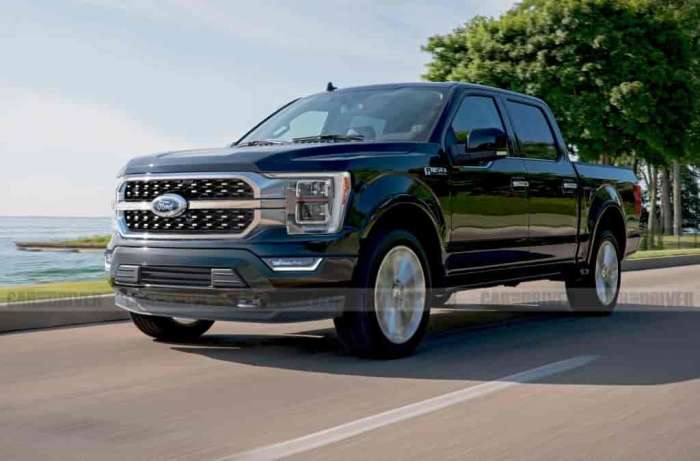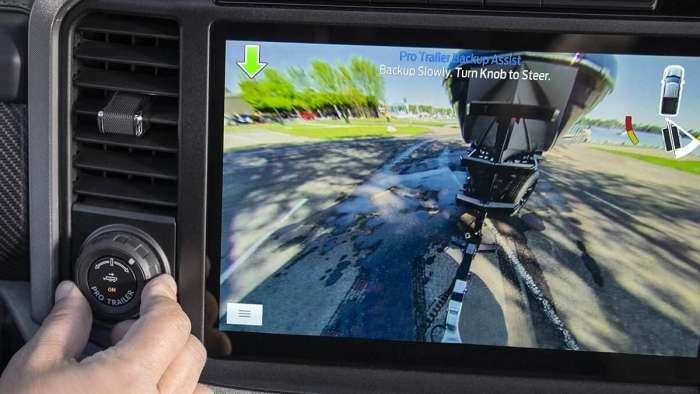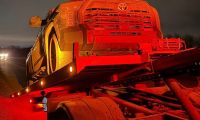In the last few days, if you've been in the East, there's little doubt that you have enjoyed balmy, above-average temperatures and interesting driving conditions. The warm weather and the leaves dropping from the trees have made things interesting for you and your F-150.
Sometimes The Road Isn’t Made For Driving
Like most vehicles, the F-150 isn't made for driving over damp roadways with leaves strewn all over the place. I know Ford will tell you otherwise – heck, they are likely to tell me otherwise – but after an automotive writing career that has spanned six decades and with access to vehicles that spans the same (1970 to now), I believe I have enough experience to make the statements that I make.
No, I do not doubt Ford and its opinions; I am just using my own experience. Why you might ask? Well, here's the thing. If you drive an F-150 and the typical owner, the chances are that it is an XLT with standard rubber.
While it is good for nice dry pavements or dry gravel or dirt surfaces, the standard rubber isn't good for much else. The tires you have on your XLT are, at best, summer-style driving tires. Ford uses them on purpose to give you a nice comfy, dry road ride. If they get a bit wet, well, there goes traction out the window.
It's not that you won't control things; it's just that the tires lose their bite. They begin to slip, and you begin to slide. Now, if you are used to driving over the speed limit and you have been able to compensate for the slip-sliding tire compound, well, more power to you.
Most drivers find that when their F150s begin to slip, they slow down. It's not surprising given the rubber that is on their wheels.
 .
.
Many Times The Road And Tires Don’t Agree
Most of the time, dealers will order F-150s with relatively inexpensive tires. It's not that they are cheap tires, just more inexpensive. The reason is so that dealers can maximize their profit per truck. So, the tires they order tend to be, as noted, lower- to mid-range. The tires are made up of a compound that tends to make for quiet rides on the highway, as well as comfortable rides, as well.
This combo's upshot means that the tread pattern isn't especially aggressive as the tires are indicated for highway cruising. The problem is that the tires don't shed water and other tires, and when you hit the brakes on the dry road, the tires have precious little reserve left for stopping in an emergency. Yes, they stop in an emergency, but they take longer to do it as you leave much of the tire on the road surface in the back of the truck.
When there are leaves on the road, the mid-range, summer-style tires have an even harder time stopping the vehicle because of their construction. The average summer-style pickup tire is made of a compound that is, as noted, can wear for a longer time – usually 30,000 to 40,000 miles – while also providing a comfortable ride.
Speaking of leafy settings, my colleague Jimmy Dinsmore discusses and interesting Bronco one-off, the Filson forest fire utility vehicle.
The handling of this type of tire is best on dry roads. If there is a bit of moisture between the tire and the road, it does begin to slip and slide. This is the situation that most drivers find themselves in at this time of year.
This year has also been unique for most of the country. For much of November, the weather is at least half the country was warm. The average temperature during the fall was somewhere over 70° Fahrenheit. This temperature scheme set up and lasted for a goodly part of the first couple of weeks of November.

Most F-150 drivers likely welcomed these temperatures. You can be confident that the temperatures made things easier for their F-150s as the temperatures were part of the trucks' optimal range. One thing that you might have noticed, though, was that it was very windy. There are several scientific reasons for this windy weather – we won't go into them here but suffice it to say it is quite familiar when you have warm days boiling up over cold nights.
Most Of The Time The Weather Is Responsible
The wind, though, was responsible for tearing many of the leaves off trees. By all accounts, the fall leaf-peeping season was very good in the East and North. Indeed, the trees held onto their leaves much until late in the falls. While the trees were great to look at, they did have something less than great for drivers.
You see, the leaves that were later in the trees and which looked so good have now fallen to the ground, and while there still hasn't been a prolonged cold snap in the East. Yes, there have been cold nights and early mornings, but by the time commuting hours roll around, the roads have usually dried, and the leaf litter they carry is drying out.
For those F-150 drivers who must drive over damp fallen leaves, they face a not-so-interesting issue. As noted, the compound of their pickup's tires tends to the more challenging side, and when they are confronted with a carpet of fallen leaves, the tires act like skis. If the leaves' carpet is thick, they face further problems as their trucks' wheels will tend to slide on the leaves as they are wet as the tires fight for traction. Also, the leaves themselves act as sliding blades in that they slide over any leaves that may be below. So, there's a double-whammy.
To deal with it, drivers have to slow down even further so that their summer tires retain their grip and so that the layers of leaves have a lessened effect. You can drive over leaves in this situation, but you can't do it too quickly.
Of course, if the F-150's tires are more aggressive, then the pickup is in better shape. If the pickup is a 4X4 with aggressive tire treading, drivers will be in the best condition possible. But remember that it is with temperatures that are still in the 40s and roadways that are still warm.
As the days turn, cold things can get downright nasty if the local highway department hasn't blown the leaves off the roadway. You see, freezing temps and wet leaves can be a rather ugly combination.
The Road Is Best By Problems
Let's say the temperatures have dropped into the 20s, and there has been a quick freeze. Since the leaves have fallen in layers, the roadway surface is likely to remain unfrozen for a period – a day or so, probably. Now, let's assume there are still layers of leaves out there. What will happen? The leaves at or near the top of the carpet of leaves will freeze up and become even more slippery than before.
Those leaves will then slip rapidly across the partially frozen layers of leaves below. Even 4X4s with aggressive tread will face slipping, and sliding and drivers will have to slow down. F-150s will indeed tend to be more successful than other trucks, but they will only be successful to a point. That point will be reached when the truck begins to slide on the nearly frozen layers of leaves. It is a dangerous cocktail of nature and technology.
Further, let's assume that the temperatures have been cold for several days and that the carpet of leaves that you have to traverse in your pickup is frozen. What will happen? The chances are good that if you approach that particular piece of roadway, the pickup will go into a slide. If there is enough room on either side of the road, then the chances are right, you will be able to control it and get through okay.
However, there are the chances that the leaves are frozen across the road surface and that the carpet of leaves is more like a skating rink than a rug. In this situation, if your angle of attack as you head into the leaves is too much, then you will enter an uncontrollable skid that will likely end up either off the road where your truck may hit a tree or another obstacle. Hopefully, you are driving slowly enough to prevent this.
You may think that some magic source will keep your truck from going into a side-to-side skid that turns you around. Well, I have to say there isn't – I experienced a similar situation several years ago where my vehicle did a 360 across four traffic lanes. When the smoke from the airbags cleared, I found that my poor vehicle was smacked up to where I ended up purchasing something different. That's what a layer of leaves and freezing temperatures can do. Indeed, you don't realize there's a problem until you have entered the leaves, and you try to turn. At that point, you notice your wheels are flailing for traction, and the body is beginning to dance.

The Best Road Advice Is Slow Down
The only advice I can offer you is to slow down. That is Torque News' cold-weather driving position. When you are entering a leaf-strewn road with freezing temperatures, you must slow down. You can't depend on speed to get you through. Speed is what anathema (not good news) to safety.
Okay, preaching aside, is there anything you can do at this time of year with temperatures dropping (they were under 30 this morning when I woke up)? The National Safety Council has said that like Torque News, your best bet is to slow down when you are entering a leaf-strewn or sand-covered section of the roadway. It will keep you safest.
Yes, it may make your trip a little longer, but what would you rather be, safe or in a vehicle that is smacked up, sitting against a guard rail? I would opt for safe.
Early sunsets and dark compound in this situation. There's nothing you can do about the calendar and when the sun sets. Indeed, as we round the middle of November, heading for December, we find that the sunsets are from the 4 p.m. to 5 p.m. range in most of the country. This means you are not only facing freezing road surfaces with varying amount of leaf and sand cover (assuming snows have already begun), but you are also facing failing light.
Now, unless you happen to own a set of night-vision goggles that will help you cut the dark, the best thing that you can do when early darkness hits is slow down. And, don't overdrive your headlights. Fortunately, today's bright whites and white LED headlights will cut through the darkness far better than headlights did even 10 years ago. But don't let that extra range fool you. It's easy to assume that you can see everything ahead – especially since F-150s do right higher than regular traffic. However, it's a false supposition because your headlight's pattern is pretty much fixed, even with the brights on.
If the weather is lousy, you have to drive with your low beams as the brights will reflect at you.
The Road Presents You With Nasty Surprises
In this situation, it is easy to come up with a carpet of frozen leaves. If you drive too fast or overdrive your headlights, the situation can get very squirrely very quickly. So, again, slowing down to the speed limit or below, depending on the weather, is your best bet.
It will keep you from sliding on a carpet of leaves right off the roadway, even with your 4X4 on. The reason for this is simple. As noted, leaves tend to freeze in layers. The top layers of leaves are the problem. Your wheels hit them, and they quickly begin to slide on the layers of leaves below. If you are driving slowly, then you have a chance to fix this problem.
But, if you are driving too fast, it is a recipe for mayhem as the leaves begin to act like sleds, with each layer having less and less drag for your truck to latch onto. If your speed is too high and you actually begin to slide on the lowest level of leaves, you will likely be in trouble.
The best thing to do in this situation is to get off the gas right away and keep from braking. Your tires have precious little to grab onto, and slowing will get you a bit more like your speed drops. Now, hopefully, your truck will have enough roadway available to slow enough so that you can brake safely.
Early dark has another problem, and that is keeping your outward visibility up. There's an interesting feature of vinyl and plastic, and it is called out-gassing. What happens is that unknown to you, the material is putting out invisible molecules of plastic that ends up being deposited on your cabin's glass surfaces.
The Road And Your Truck Present Surprises
That's why, over time, your vehicle's windshield and side windows accumulates a layer of blue. It does take time, and you tend to work around it, but it develops, and it can cut your visibility severely so that even with the brightest white headlights, your forward vision is cut. The solution to this is the frequent cleaning of all interior glass surfaces. It pays dividends in foul weather, as well.
So there you have it. If you follow Torque News' recommendations presented in this story, you will find you can get your F-150 through any situation. Just slow down and keep things clean and you are all set.
Marc Stern has been an auto writer since 1971. It was a position that filled two boyhood dreams: One was that I would write, and two that I write about cars. When I took over as my newspaper's auto editor, I began a 32-year career as an automotive columnist. There isn't much on four wheels that I haven't driven or reviewed. My work has appeared in Popular Mechanics, Mechanix Illustrated, AutoWeek, SuperStock, Trailer Life, Old Cars Weekly, Special Interest Autos, and others. Today, I am the Ford F150 reporter for Torque News. I write how-to and help columns for online sites such as Fixya.com and others. You can follow me on Twitter or Facebook. Most of Marc's stories can be found at Torque News Ford coverage. Check back again and search for Torque News Ford F-150 news for more F-150 truck news coverage.












